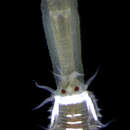Biology
provided by World Register of Marine Species
E. sanguinea breeds in early summer and has planktonic larvae. In the estuarine Delta area juvenile benthic stages are mainly observed in June-July. E. sanguinea is a predatory carnivore and is itself eaten by fish. The species has been observed to live as a commensal of the tubicolous polychaete Lanice conchilega (Hartmann-Schröder, 1971; Wolff, 1973).
Holtmann, S.E.; Groenewold, A.; Schrader, K.H.M.; Asjes, J.; Craeymeersch, J.A.; Duineveld, G.C.A.; van Bostelen, A.J.; van der Meer, J. (1996). Atlas of the zoobenthos of the Dutch continental shelf. Ministry of Transport, Public Works and Water Management: Rijswijk, The Netherlands. ISBN 90-369-4301-9. 243 pp.
- license
- cc-by-4.0
- copyright
- WoRMS Editorial Board
Description
provided by World Register of Marine Species
Bristle worm with a rather corpulent, ventrally flattened body up to 60 mm long. The uniform segments feature distinct parapodia on which the dorsal lamellas are clearly visible. The head has two large black eyes and five antennae, one of which in the middle of the head. Four pairs of rather long, thin tentacles. The colour varies from greyish white with brown spots to reddish brown with white transverse bands. Eumida sanguinea often lives in association with the sand mason Lanice conchilega.
Degraer, S.; Wittoeck, J.; Appeltans, W.; Cooreman, K.; Deprez, T.; Hillewaert, H.; Hostens, K.; Mees, J.; Vanden Berghe, E.; Vincx, M. (2006). The macrobenthos atlas of the Belgian part of the North Sea. Belgian Science Policy. D/2005/1191/3. ISBN 90-810081-6-1. 164 pp.
- license
- cc-by-4.0
- copyright
- WoRMS Editorial Board
Distribution
provided by World Register of Marine Species
Gulf of St. Lawrence to Georgia, Gulf of Mexico, Venezuela, Mexico, Indian Ocean
North-West Atlantic Ocean species (NWARMS)
- license
- cc-by-4.0
- copyright
- WoRMS Editorial Board
Distribution
provided by World Register of Marine Species
Fide Oliveira et al (2015) all prior Brazilian records (Duarte & Nalesso 1996; Duarte 1980; Morgado & Amaral 1984; Nogueira 2000; Amaral et al. 2006–12) of Eumida sanguinea should be referred to Eumida dracodermica.
De Oliveira, Verônica Maria; Eibye-Jacobsen, Danny; Lana, Paulo da Cunha. (2015). Description of three new species of Eumida Malmgren, 1865 (Phyllodocidae, Annelida) from Southern and Southeastern Brazil. Zootaxa. 3957(4): 425-440.
- license
- cc-by-4.0
- copyright
- WoRMS Editorial Board
Distribution
provided by World Register of Marine Species
E. sanguinea has a patchy distribution in the sandy sediments of the Dutch Continental Shelf. lt is furthermore found in the Oosterschelde and in the eastern and western Wadden Sea.
Holtmann, S.E.; Groenewold, A.; Schrader, K.H.M.; Asjes, J.; Craeymeersch, J.A.; Duineveld, G.C.A.; van Bostelen, A.J.; van der Meer, J. (1996). Atlas of the zoobenthos of the Dutch continental shelf. Ministry of Transport, Public Works and Water Management: Rijswijk, The Netherlands. ISBN 90-369-4301-9. 243 pp.
- license
- cc-by-4.0
- copyright
- WoRMS Editorial Board
Distribution
provided by World Register of Marine Species
Eumida sanguinea mainly occurs in the near-coastal zone. In the 1976-1986 the species had a low frequency of occurrence but was found across the entire near-coastal zone. The density was limited to a maximum of only 800 ind./m2. In the 1994-2001 period the frequency of occurrence increased, but the species appeared to be absent in the eastern coastal zone. The highest frequency of occurrence and density levels (up to 3,500 ind./m2) were observed in the western coastal zone and in the southern part of the Zeeland Banks.
Degraer, S.; Wittoeck, J.; Appeltans, W.; Cooreman, K.; Deprez, T.; Hillewaert, H.; Hostens, K.; Mees, J.; Vanden Berghe, E.; Vincx, M. (2006). The macrobenthos atlas of the Belgian part of the North Sea. Belgian Science Policy. D/2005/1191/3. ISBN 90-810081-6-1. 164 pp.
- license
- cc-by-4.0
- copyright
- WoRMS Editorial Board
Habitat
provided by World Register of Marine Species
E. sanguinea has been reported from muddy sand, among algae and also under stones, in kelp holdfasts and among old shells (Hartmann-Schröder, 1971; Wolff, 1973; Hayward & Ryland, 1990).
Holtmann, S.E.; Groenewold, A.; Schrader, K.H.M.; Asjes, J.; Craeymeersch, J.A.; Duineveld, G.C.A.; van Bostelen, A.J.; van der Meer, J. (1996). Atlas of the zoobenthos of the Dutch continental shelf. Ministry of Transport, Public Works and Water Management: Rijswijk, The Netherlands. ISBN 90-369-4301-9. 243 pp.
- license
- cc-by-4.0
- copyright
- WoRMS Editorial Board
Habitat
provided by World Register of Marine Species
Eumida sanguinea occurs in a wide spectrum of sediment types: the species only avoids sediments with a median grain size > 500 µm or with a mud content > 40%. An optimum is reached in sediments with a median grain size of 150-250 µm and a mud content of 10-40%. The high relative occurrence in sediments with a mud content of 80-90% is considered relatively unreliable in view of the low number of observations for this mud content.
Degraer, S.; Wittoeck, J.; Appeltans, W.; Cooreman, K.; Deprez, T.; Hillewaert, H.; Hostens, K.; Mees, J.; Vanden Berghe, E.; Vincx, M. (2006). The macrobenthos atlas of the Belgian part of the North Sea. Belgian Science Policy. D/2005/1191/3. ISBN 90-810081-6-1. 164 pp.
- license
- cc-by-4.0
- copyright
- WoRMS Editorial Board
Morphology
provided by World Register of Marine Species
A species with a stout, dorsally convex body, up to 30 mm in length and made up of 60-140 segments. The uniform segments have distinct parapodia bearing a dorsal lamella. The head has two fairly large black eyes and five antennae. The colour is variable, ranging from greyish white with brown spots through yellowish green to reddish brown with white transverse bands (Hartmann-Schröder, 1971; Hayward & Ryland, 1990).
Holtmann, S.E.; Groenewold, A.; Schrader, K.H.M.; Asjes, J.; Craeymeersch, J.A.; Duineveld, G.C.A.; van Bostelen, A.J.; van der Meer, J. (1996). Atlas of the zoobenthos of the Dutch continental shelf. Ministry of Transport, Public Works and Water Management: Rijswijk, The Netherlands. ISBN 90-369-4301-9. 243 pp.
- license
- cc-by-4.0
- copyright
- WoRMS Editorial Board

